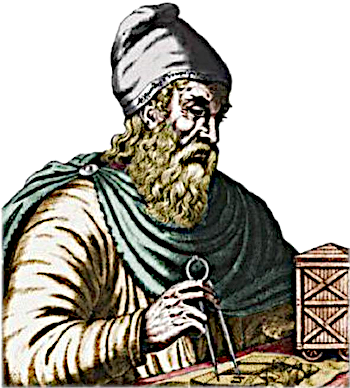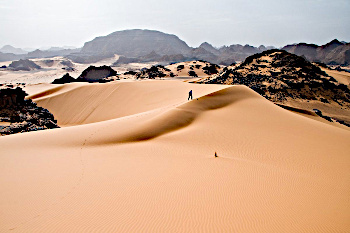Sand
October 18, 2021
One of the most important
Ancient Greek texts is
The Sand Reckoner (Ψαμμίτης, Psammites) by
Greek mathematician,
Archimedes of Syracuse (Ἀρχιμήδης, c.287-c.212 BC). In this work, Archimedes estimates an
upper bound for the number of
grains of
sand that would fill the
universe. This
calculation involved an early
estimate the size of the universe, as well as a
notation for extremely large numbers.

Archimedes of Syracuse (c.287-c.212 BC).
Another of the works of Archimedes is his c.250 BC Measurement of a Circle. A portion of this work gives an approximation of the mathematical constant, pi, as follows: 3 and 10/71 < π < 3 and 1/7. This places pi between 3.14084 and 3.14285.
He found these limits by calculating the perimeters of circumscribed and inscribed 96-sided regular polygons.
(Wikimedia Commons image.)
The largest
Greek number at that time was the
myriad, the word for 10,000 that we use in
English to denote
a countless number or multitude of a specified item. Archimedes created larger numbers by construction of such objects as
myriad myriads (10
8). Archimedes used the
heliocentric model of
Aristarchus of Samos, he assumed that the universe was
spherical, and that the
ratio of the
diameter of the universe to the diameter of the
Earth's orbit around the
Sun was equal to the ratio of the diameter of Earth's orbit around the Sun to the diameter of the
Earth.
Plugging in some values for these distances gave a diameter of the universe of just two
light years. Archimedes calculated that 10
63 grains of sand of about 18.3
μm (0.0183
mm) in diameter would be sufficient to fill it. His estimate for the size of a grain of sand was based on his observation that a
poppy seed could contain a myriad (10,000) grains of sand. Modern
metrology shows that a small grain of sand is about 62.5 μm (0.0625 mm) in diameter. Large grains of sand are about two millimeters in diameter. The
volume of the
observable universe is 3.566 x 10
80, so I calculate that the universe can contain about 10
93 grains of sand.

This passage at the end of The Sand Reckoner is translated, "I conceive, King Gelon, that among men who do not have experience of mathematics, such a thing might appear incredible...."
It's difficult for anyone to have a working knowledge of everything, and that's a reason why politicians have such limited knowledge of science and mathematics. While most defer to experts for opinions in such subject areas, some are hostile to science and scientists for bringing too much bad news.
The Sand Reckoner was addressed to Gelon II, the King of Syracuse, and Archimedes acknowledged this problem in his time. (Greek text from Ref. 2.[2] English translation from Ref. 3.[3])
Sand appears to be plentiful in the world. Along with
gravel and
crushed stone, it's one of the most
mined materials, used for making
concrete and the
silicon needed for making
integrated circuits. The
erosion forces of
water and
wind create sand grains over
geological time scales. While water-eroded sand is suitable for making concrete, the wind-eroded sand of
deserts is too
smooth for this application. Sand found inland is generally composed of
silica (silicon dioxide, SiO2) created from eroded
quartz.
Beach sand is generally
calcium carbonate (CaCO3) created from
aragonite. Sand is a non-
renewable resource, and about 50 billion
tons of sand and gravel are used
annually in
construction.[5]
A recent review article in the
journal,
One Earth, examines the idea of
sustainable sand use as measured against the
sustainable development goals established by the
United Nations.[6] Study
authors were from
McGill University (Montreal, Canada), the
University of Copenhagen (Copenhagen, Denmark), the
University of Illinois at Urbana-Champaign (Urbana, Illinois), The
University of Queensland (Brisbane, Australia),
Newcastle University (Newcastle upon Tyne, United Kingdom), the
Federal University of Goiás (Goiâum;nia, Brazil), and the
London School of Hygiene & Tropical Medicine (London, United Kingdom).[6] They conclude that the practices of the sand industry conflict with eight of the 17 UN goals.[6-7]

Sand dunes in Tadrart Acacus, a desert area in western Libya, part of the Sahara Desert.
concrete can't be made from desert sand, since the grains are too smooth.
The phrase, "Water, water, everywhere, nor any drop to drink...," from the The Rime of the Ancient Mariner by Samuel Taylor Coleridge (1772-1834) can be re-imagined as "Sand, sand, everywhere, nor any grain to use."
(A 2007 photo by Luca Galuzzi, via Wikimedia Commons.)
While sand is the most used
mineral in the world and a main component of
modern civilization, there's a limited supply, and
nature makes sand at too low a rate for it to be sustainable at the present level of its use.[7] The study focused on low- and middle-income
countries, and the
research team examined sand production with respect to the
United Nations Sustainable Development Goals, a
holistic scale of broad topic areas that's independent of the specific
resource analyzed.[6] They found that the sand industry conflicts with eight of the 17 of the goals.[6] While I find that several of these goals are too general and not easily
quantifiable (e.g.,
Peace, justice and strong institutions), there are some that demand attention. These are
• Clean water and sanitation
• Responsible consumption and production
• Climate action
• l
Life below water
• Life on land
Says study author,
Lars Lønsmann Iversen of the University of Copenhagen,
"Sand is the most used resource in the world, next to water, but the way it is extracted is in direct conflict with eight of the 17 UN Sustainable Development Goals. We do not have endless amounts of sand, and within the next 50 years we expect it to be in short supply. It is therefore vital that we are now able to point to significant sustainability issues involving the world's sand resources."[7]
Sand is excavated mostly from
mines and along
rivers in low- and middle-income countries, and therein lies most of the problem.[7] Such mining at rivers comes with great
environmental and local
human quality of life impact.[7] Removal of sand along rivers changes their natural boundaries and their natural
flow. Sudden removal of sand affects the
sediment discharge in these rivers and causes increased
erosion and an increased risk of
flooding.[7]
Drinking water is also affected.[7] Says Iversen,
"The negative consequences are to a large extent due to the fact that sand is an unregulated resource. Unregulated resources can be misused and exploited by rich countries. The human consequences of these activities can be solved by regulating the way the resource is used locally. For example, the miners may suffer from poor working conditions. The precious metal and diamond industries are already focusing on this issue, but in the sand industry it has gone more or less undetected."[7]
These problems must be balanced against the positive aspects of the sand industry. It provides millions of
jobs in
developing countries, and sand is an important component in the
economic development in these developing countries.[7]
Alternatives to sand are being investigated, such as use of
plastic instead of sand as an
asphalt additive. I wrote about asphalt and other
paving materials in an
earlier article (Paving Materials, July 13, 2020).
Engineered wood can replace concrete in some
buildings. Research is also underway on manipulating desert sand to make it a suitable concrete additive.[7]

The Sandman is a mythical character who induces sleep and encourages dreams by sprinkling magical sand onto a person's eyes.
In Scandinavian folklore, the Sandman (as depicted) is called "Ole Lukøje".
The origin of the myth is the sand-like rheum, the crust in the corners of the eyes seen upon waking.
(A depiction of Ole Lukøje by Vilhelm Pedersen, via Wikimedia Commons)
References:
- Archimedes, "The Sand Reckoner," Greek text at The Computer Science Laboratory of Ecole Polytechnique (Postscript file).
- Archimedes, "The Sand Reckoner," Greek text at the Personal Web Page of Heinrich F. Fleck (PDF file).
- Archimedes, "The Sand Reckoner," English translation at the website of Ilan Vardi (Postscript file).
- Ilan Vardi, "The Legacy of Archimedes (287-212 B.C.), Departement d'Informatique, Ecole Polytechnique, Palaiseau, France .
- Vince Beiser, "Why the world is running out of sand," BBC, November 18, 2019
- Mette Bendixen, Lars L. Iversen, Jim Best, Daniel M. Franks, Christopher R. Hackney, Edgardo M. Latrubesse, and Lucy S. Tusting, "Sand, gravel, and UN Sustainable Development Goals: Conflicts, synergies, and pathways forward," One Earth, vol. 4, no. 6 (August 20, 2021), pp. 1095-1111, https://doi.org/10.1016/j.oneear.2021.07.008.
- Sand is one of our most used resources, but the industry is not sustainable, University of Copenhagen Press Release, August 31, 2021.
Linked Keywords: Ancient Greek; The Sand Reckoner (Ψαμμίτης, Psammites); Greece; Greek; mathematician; Archimedes of Syracuse (Ἀρχιμήδης, c.287-c.212 BC); upper bound; grain; sand; universe; calculation; estimation; estimate; notation; Measurement of a Circle; approximation; mathematical constant, pi; perimeter; circumscribed; inscribe; regular polygon; Wikimedia Commons; Greek language; myriad; English language; a countless number or multitude of a specified item; heliocentrism; heliocentric model; Aristarchus of Samos; sphere; spherical; ratio; diameter; Earth's orbit; Sun; Earth; light year; micrometer; μm; millimeter; mm; poppy seed; metrology; volume; observable universe; passage; politician; science; mathematics; expert; opinion; Gelon II, the King of Syracuse; gravel; crushed stone; mining; mined; material; concrete; silicon; integrated circuit; erosion force; water; wind; geological time scale; desert; surface roughness; smooth; silica (silicon dioxide, SiO2); quartz; beach; calcium carbonate (CaCO3); aragonite; renewable resource; ton; annual; construction; scientific journal; One Earth; sustainable development; Sustainable Development Goals; United Nations; author; McGill University (Montreal, Canada); University of Copenhagen (Copenhagen, Denmark); University of Illinois at Urbana-Champaign (Urbana, Illinois); University of Queensland (Brisbane, Australia); Newcastle University (Newcastle upon Tyne, United Kingdom); Federal University of Goiás (Goiâum;nia, Brazil); London School of Hygiene & Tropical Medicine (London, United Kingdom); sand dune; Acacus Mountains; Tadrart Acacus; Libya; Sahara Desert; concrete; phrase; The Rime of the Ancient Mariner; Samuel Taylor Coleridge (1772-1834); Luca Galuzzi; mineral; modern civilization; nature; country; research; United Nations Sustainable Development Goals; holism; holistic; natural resource; analysis; analyze; measurement; quantifiable; sanitation; consumption (economics); production (economics); climate action; life; underwater; land; Lars Lønsmann Iversen; mining; mine; river; environmental quality; human; quality of life; fluid dynamics; flow; sediment; discharge (hydrology); erosion; flood; flooding; drinking water; regulation; unregulated resource; precious metal; diamond; employment; job; developing country; economic development; plastic; asphalt; additive; road surface; paving material; engineered wood; building; Sandman; mythology; mythical character; sleep; dream; magic; magical; eye; Scandinavian; folklore; Ole Lukøje; rheum; Vilhelm Pedersen.